(Press-News.org) Bopha intensified into a typhoon today, Nov. 30, as it continues to affect the islands in Micronesia in the western North Pacific Ocean. NASA's TRMM satellite captured rainfall data of Bopha and noticed "Hot Tower" thunderstorms as it was intensifying from a tropical storm into a typhoon.
When NASA and the Japanese Space Agency's Tropical Rainfall Measuring Mission (TRMM) satellite passed over Bopha twice on Nov. 29, and the later data showed that the area of heaviest rainfall had expanded and was still south of the center of circulation. The heaviest rainfall was occurring at a rate of 2 inches/50 millimeters per hour.
TRMM data also showed several "hot towers" within Tropical Storm Bopha. A "hot tower" is a tall cumulonimbus cloud that reaches at least to the top of the troposphere, the lowest layer of the atmosphere. It extends approximately nine miles (14.5 km) high in the tropics. The hot towers in Bopha were over 9.3 miles (15 km) high. These towers are called "hot" because they rise to such altitude due to the large amount of latent heat. Water vapor releases this latent heat as it condenses into liquid. NASA research shows that a tropical cyclone with a hot tower in its eyewall was twice as likely to intensify within six or more hours, than a cyclone that lacked a hot tower. It was after TRMM spotted the hot towers in Bopha that the storm intensified into a typhoon.
On Nov. 30 at 10 a.m. EST (1500 UTC/1 a.m. CHST local time on Dec. 1), the National Weather Service in Guam urged residents in Koror, Kayangel and Sonsorol in the Republic of Palau and Yap Island and Ngulu Atoll in Yap State to prepare for typhoon conditions. A typhoon watch remains in effect for Ngulu in Yap State and Koror and Kayangel in the Republic of Palau. A tropical storm watch remains in effect for Yap Island in Yap State and Sonsorol in the Republic of Palau.
At 1 a.m. CHST local time on Dec. 1, (1500 UTC/10 a.m. EST, U.S. on Nov. 30) the center of Typhoon Bopha was located near latitude 4.4 degrees north and longitude 143.8 degrees east. Bopha's center was about 510 miles east-southeast of Ngulu, about 525 miles southeast of Yap, and 675 miles east-southeast of Koror Palau and Kayangel. Bopha's maximum sustained winds remain at 75 mph (120.7 kph) and the storm is expected to slowly intensify over the next day. Typhoon Bopha is moving west-northwestward at 12 mph and little change is expected in this movement through Saturday, Dec. 1.
According to the National Weather Service in Guam, "Typhoon force winds extend outward up to 20 miles from the center and tropical storm force winds extend outward up to 85 miles from the center."
Typhoon Bopha is expected to continue moving toward west-northwest. The National Weather Service official forecast track takes Bopha south of Ngulu and very close to the islands of Koror and Kayangel in the Republic of Palau. As Bopha draws closer and intensifies, winds could reach typhoon intensity (as high as 74 mph/ 64 knots/119 km/h). Surf will be very rough and rainfall can reach up to 4 inches on Saturday and up to an additional 6 inches on Sunday/Monday. Residents can expect local flooding and mudslides. The most recent National Weather Service updates can be found here: http://www.prh.noaa.gov/koror/kororCyclone.php.
Forecasters at the Joint Typhoon Warning Center forecast Bopha's center to pass close to Palau on its way to the Visayas region of Philippines by Dec. 4. Residents in the Philippines need to prepare for heavy rains, rough surf and strong winds.
INFORMATION:
NASA sees 'hot towers' in intensifying Typhoon Bopha
2012-12-01
ELSE PRESS RELEASES FROM THIS DATE:
Emerging vector-borne diseases create new public health challenge
2012-12-01
Human activities are advancing the spread of vector-borne, zoonotic diseases such as West Nile virus, Lyme disease and dengue fever, report scientists publishing a series of papers today in the journal The Lancet.
Vector-borne zoonotic diseases result from disease-causing agents or pathogens that naturally infect wildlife, and are transmitted to humans by carriers such as mosquitoes and ticks. In short, they're diseases transmitted between animals and humans.
Widespread land-use change, globalization of trade and travel, and social upheaval are driving the emergence ...
ORNL develops lignin-based thermoplastic conversion process
2012-12-01
Turning lignin, a plant's structural "glue" and a byproduct of the paper and pulp industry, into something considerably more valuable is driving a research effort headed by Amit Naskar of Oak Ridge National Laboratory.
In a cover article published in Green Chemistry, the research team describes a process that ultimately transforms the lignin byproduct into a thermoplastic – a polymer that becomes pliable above a specific temperature. Researchers accomplished this by reconstructing larger lignin molecules either through a chemical reaction with formaldehyde or by washing ...
Preventing 'Cyber Pearl Harbor'
2012-12-01
Cyber attacks that have long caused major work disruption and theft of private information are becoming more sophisticated with prolonged attacks perpetrated by organized groups. In September 2012, Bank of America, Citibank, the New York Stock Exchange, and other financial institutions were targets of attacks for more than five weeks. Defense Secretary Leon E. Panetta warned that the United States was facing the possibility of a "cyber-Pearl Harbor" and was increasingly vulnerable to foreign computer hackers who could disrupt the government, utility, transportation, and ...
NASA's TRMM satellite video reveals 2012 hurricane season rainfall
2012-12-01
The 2012 Atlantic Hurricane season was a busy one as there were 19 tropical cyclones. A new NASA animation using data from the Tropical Rainfall Measuring Mission satellite known as TRMM shows rainfall from tropical cyclones in the western Atlantic, as measured from space.
The TRMM satellite has now been making highly accurate measurements of rainfall from space for fifteen years since it launched in Nov. 1997. TRMM is a joint mission between NASA and the Japanese space agency, JAXA.
TRMM can be used to calibrate rainfall estimates from other satellites. Those rainfall ...
In schizophrenia patients, auditory cues sound bigger problems
2012-12-01
Researchers at the University of California, San Diego School of Medicine and the VA San Diego Healthcare System have found that deficiencies in the neural processing of simple auditory tones can evolve into a cascade of dysfunctional information processing across wide swaths of the brain in patients with schizophrenia.
The findings are published in the current online edition of the journal Neuroimage.
Schizophrenia is a mental disorder characterized by disturbed thought processes and difficulty in discerning real from unreal perceptions. Common symptoms include auditory ...
Steroid injection linked with significant bone loss in postmenopausal women treated for back pain
2012-12-01
DETROIT – Postmenopausal women suffered significant bone density loss in their hip after they were treated with an epidural steroid injection for back pain relief, according to a Henry Ford Hospital study
Bone density loss after six months was six times greater when compared to the typical bone density loss seen in a year in a postmenopausal woman who doesn't receive steroid injection, researchers say.
Shlomo Mandel, M.D., a Henry Ford orthopedic physician and the study's lead author, says physicians should exercise caution prescribing an epidural steroid for select ...
Lung cancer patients with pockets of resistance prolong disease control by 'weeding the garden'
2012-12-01
The central skill of cancer is its ability to mutate – that's how it became cancerous in the first place. Once it's started down that path, it's not so difficult for a cancer cell to mutate again and again. This means that different tumors within a single patient or even different areas within the same cancerous deposit may develop different genetic characteristics. This heterogeneity helps cancer escape control by new, targeted cancer therapy drugs.
Two of these targeted drugs are crizotinib and erlotinib – they do wonders for the patients whose cancers depend on the ...
Extended sleep reduces pain sensitivity
2012-12-01
DARIEN, IL – A new study suggests that extending nightly sleep in mildly sleepy, healthy adults increases daytime alertness and reduces pain sensitivity.
"Our results suggest the importance of adequate sleep in various chronic pain conditions or in preparation for elective surgical procedures," said Timothy Roehrs, PhD, the study's principal investigator and lead author. "We were surprised by the magnitude of the reduction in pain sensitivity, when compared to the reduction produced by taking codeine."
The study, appearing in the December issue of the journal SLEEP, ...
Long-term research reveals how climate change is playing out in real ecosystems
2012-12-01
NORTH WOODSTOCK, N.H., December 1, 2012—Around the world, the effects of global climate change are increasingly evident and difficult to ignore. However, evaluations of the local effects of climate change are often confounded by natural and human induced factors that overshadow the effects of changes in climate on ecosystems. In the December issue of the journal BioScience, a group of scientists writing on long-term studies of watershed and natural elevation gradients at the Hubbard Brook Experimental Forest in New Hampshire and in the surrounding region report a number ...
X-ray analysis deciphers master regulator important for skin cancer
2012-12-01
This press release is available in German.
With the X-ray vision of DESY's light source DORIS, a research team from Hamburg and Iceland has uncovered the molecular structure of a master regulator central to the most deadly form of skin cancer, melanoma. The results, published in the scientific journal "Genes & Development", throw new light on the workings of the so-called Microphthalmia-associated Transcription Factor MITF, that is not only connected to skin cancer, but also to a variety of hereditary diseases where the production of the skin pigment melanin is disturbed, ...



